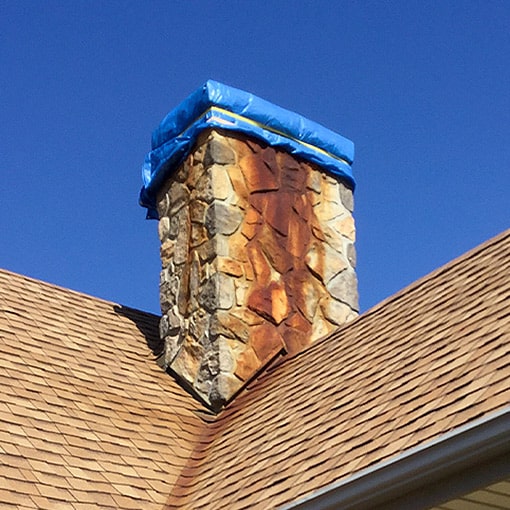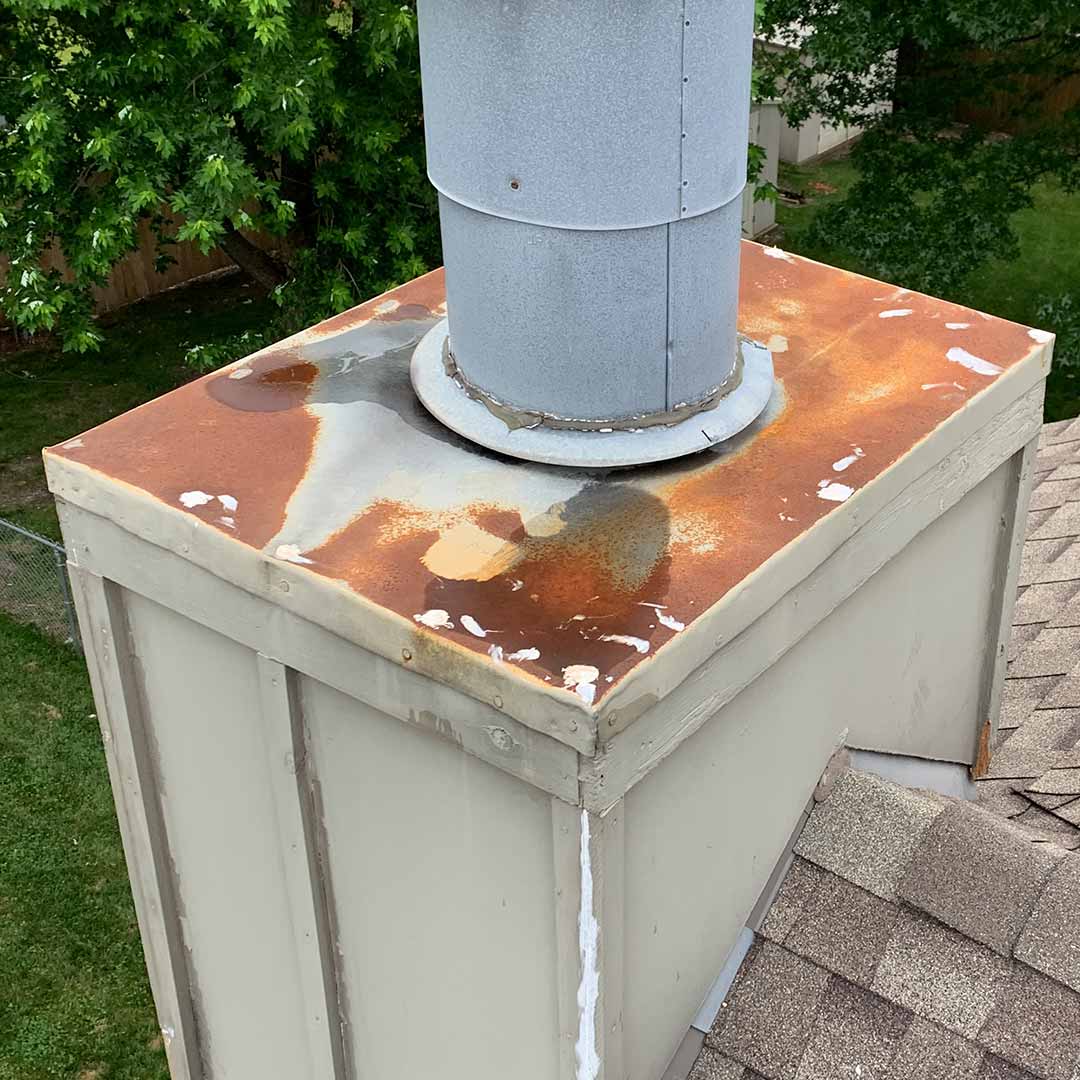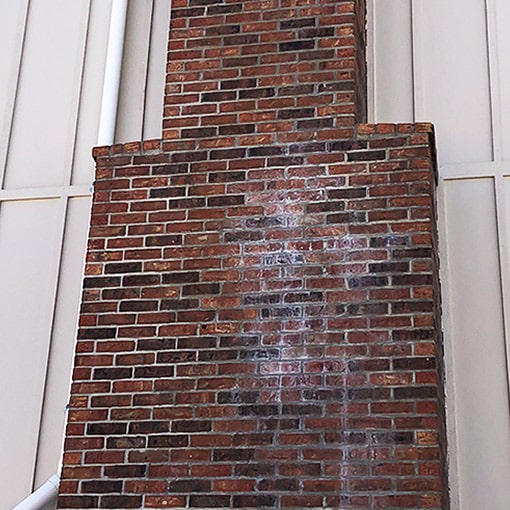When roofs, chimneys, or fireplaces show signs of staining or discoloration, there are a variety of causes. Whether the stains are interior or exterior, it’s NOT an attractive look and can devalue your home. Today we help you Learn How to Identify Types of Chimney Stains.
Plus we’ll review options for how to remove stains from brick or stone. While this post will focus on masonry structures, we will briefly touch on other surfaces.
A few TOPICS this post covers:
- Causes of soot and smoke stains
- Different types of brick discoloration
- Options for preventing or cleaning brick stains
- Potential causes of chimney staining sorted by colors. (Click the color below to skip ahead to any section).
What Causes Stains on Chimney and Bricks
There are quite a few reasons for the abnormal discolored stains in many different forms—patches or spotting in all shapes, sizes, and colorations.
Whether the tall structures on your roof are made of brick, stone, wood/metal prefab, or even covered in stucco, you’re still at risk for different types of chimney stain problems.
That is unless the builders or previous homeowners took the proper precautions to protect against deterioration.
The majority of what we’ll discuss here are related to stains on porous masonry materials, but we’ll also talk a bit about rust on prefab chases.
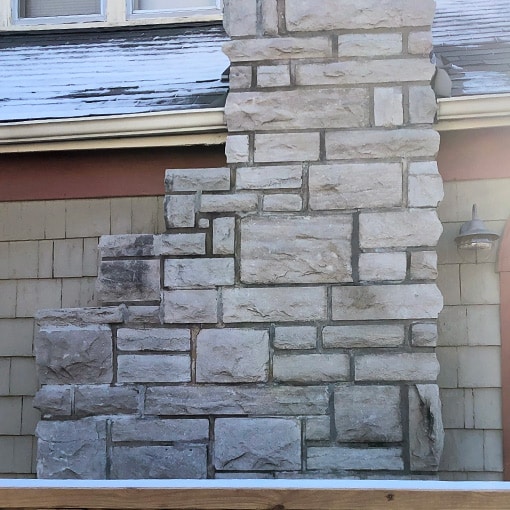
Example Image: Black stains on the side of a stone chimney
Common Reasons Why it Happens
While not an exhaustive list, here are the most common reasons why different types of stains develop on chimneys or other structures like brick/stone, walls, asphalt shingles/roofs, and of course, fireplaces:
- Algae Growth
- Creosote
- Corrosion / Rust
- Mineral Salts
- Mildew / Mold
- Paint Run-Off
- Soot Build-Up
Can You Guess: What caused the stain on the roof surrounding this chimney?
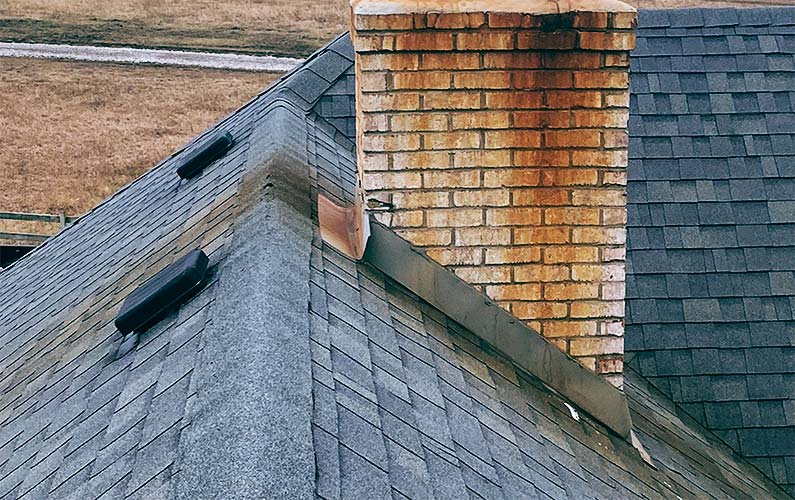
Identify the Problem
First off, what do you see?
If you’ve noticed any unusual spots or discolorations on your chimney (or fireplace), then you probably want to know how to get rid of those brick stains and reclaim what was once a beautiful structure on your roof (or hearth)!
Have you noticed any of the following happening at home?
- Black soot smudges showing up in places where they shouldn’t… (like outside the fireplace or down the side of the chimney walls!)
- Is your roof staining from the chimney?
- White powder on your bricks or walls?
Perhaps when you walk into your living room, all you can see is what resembles “smoke stains” above your fireplace? (Hint: it’s not smoke, it’s soot residue and it’s a bad sign.)
Whatever it is, we feel your pain because we’ve seen it before! Now we’re here to help you troubleshoot your hearth and roof staining problems.
Observe to Troubleshoot Surface Area Discolorations
If you’re still reading, then it’s likely you already know you have a stain on your roof, chimney, or fireplace. It may be relevant to other surfaces too, like outdoor walls, etc.
Now you want to learn how to get rid of chimney stains… how to remove stains on your roof/ shingles. It must be understood that simply REMOVING the stains, does NOT SOLVE the problem.
So if you want more than a temporary fix; if you want a real solution… it starts by knowing what is causing the surface discolorations. Let’s explore a few things that you can see from the ground without assistance or needing a ladder:
Look up at your roof and chimney:
- What color are the stains?
- How large is the stained surface?
- Where are the discolored spots located?
- How long have the surface discolorations been noticeable?
- If you are close enough to see the spot’s texture that can also help, but from the ground, it may be too far away.
Having this information helps you do your research then decide what course of action to take next. If you decide to call for professional help, you’ll be prepared to make that call.
Rusting Can Cause a Red/Brown Stain on Stone Chimneys and Roofing BUT there could be other problems that show up with similar symptoms!
Note: For safety reasons, if a ladder is required, then we recommend calling a certified professional to help you with an evaluation.
What Color is the Stain on your Roof/Chimney/Fireplace?
Understand that different discolorations signify various problems. So it’s important to consult a professional if you’re not sure. Let’s take a closer look to identify the causes of discolored chimneys based on the color of the stain you see.
When trying to Identify the Different Types of Chimney Stains it helps to observe the texture and color of the abnormality.
Click on any color below to skip ahead to the appropriate section.
The most common discolorations found on brick, stone, and rooftops are:
DIY Warning: There are steps people can take to fix or reduce staining problems. Just be aware that some of these stains are easily mistaken for something else. If you attempt to do it yourself and clean stains off brickwork without professional assistance, you risk misidentifying the problem. Using the wrong corrective treatment for removal may result in worse damage.
With that said, there’s a lot we can learn from the color, shape, and overall appearance of the staining on your brickwork, stone, or other porous building materials.
Note: If you see visible stains indoors on a ceiling or the walls near your fireplace, it signifies a more serious underlying issue that needs addressed.
Black
The most common cause of black stains is soot. It can happen to your fireplace or could be what’s causing the black streaks down the shingles on your rooftop. Let’s talk about the location. There’s a big difference between the black stains on bricks outside versus those dark sooty smudges you see indoors above your fireplace. Both are problems when it comes to the safety of the home’s fireplace venting system.
INTERIOR: Soot Stains Above Fireplace
Usually found in older homes, these indoor soot stains appear as black smearing or smudges above an open-hearth fireplace. You and everyone who walks into the room will notice these fireplace stains.
We’ve heard it called “Smoke Stain” and people think it’s a normal part of having a fireplace, but that’s a dangerous assumption!
When you start to notice soot or “smoke stains,” then it signals a much bigger problem.
Read more about what causes soot staining problems and what steps you can take to avoid it.
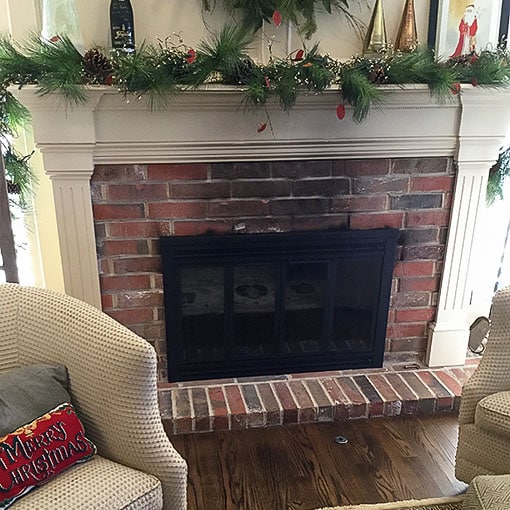
The staining above your fireplace needs cleaned, but cleaning the black spot won’t solve your underlying fireplace problems.
Removal Tips:
How to clean soot from outside the firebox/on the front-facing of fireplace:
First, we recommend NOT using any vinegar or baking soda, or other homemade cleaning solutions as commonly found online. Since vinegar is an acid, you risk damaging perfectly good bricks, stones, or veneer facings, etc.
Instead, we prefer a professional product called Paint ‘N’ Peel. Always follow the manufacturer’s instructions.
(OR you can always hire a contractor to do the work for you!)
How to clean the soot inside the firebox:
- Remove the grate.
- Remove the ashes from the firebox.
- Brush bricks to remove soot and ash.
- Mask-off firebox where it meets the facing, then spray (take precaution for overspray).
- Optional: You could also finish it by covering it up by rolling on a dark high-temperature paint.
See steps for How to Clean Black Stains Off Firebricks
EXTERIOR: Roof Staining From Chimney Soot
As seen on roof shingles, soot staining most often happens with freestanding stoves or the wood insert type of fireplace systems. If you’ve got black soot stains on the outside of your chimney, then this means there are excessive amounts of build-up caused by creosote inside your flue, which is dangerous.
The worst-case scenario could result in an unintended flue fire. The best-case scenario is you catch it BEFORE disaster strikes and have the opportunity to make necessary repairs to help prevent these problems from happening in the future.
Warning: If you have a gas-burning system and you notice outdoor/exterior stains that look like sooty black residue, then seek help immediately. It could sign a malfunction causing Carbon Monoxide (C.O.) to leak inside the home.
Other Causes
As mentioned above, the causes of black stains on your chimney could be creosote, mold, or mildew.
If you have an oil-burning system, then that oil can also cause soot staining problems. Which we won’t go into in this post. We don’t see too many oil systems in the midwest.
Dark Green or Brown
If your chimney stains color is a shade of dark green or brown, it could be caused by an organic compound like moss, mold, or algae growth. Since there are different types of algae, the stained surface’s color and texture can vary depending on the type of organic growth forming. Some can even appear black, like black mold.
Why it Happens
Weather and seasonal characteristics of your local climate, like sustained high humidity, could play a factor. So you may see more moss and algae growth in a location that has a more extended rainy season than in a dryer climate.
In the midwest, we see the moisture that causes the algae or mold to grow on people’s rooftops is not usually caused by weather or climate. Instead, it’s coming from inside the chimney or fireplace itself! Rain, snow melting, and condensation could all be a small part of the problem.
If algae, moss, mold, mildew, or any other organic compounds are growing on the outside of your roofs or chimneys, water is getting inside your home and causing unseen damage! Which is cause for concern and a good reason to have the full system inspected to determine what’s causing the dampness in your flue.
Biological growths (moss/algae) are not the problem, but a symptom of it.
Removal
Call your local service professionals to address the underlying cause. Make sure to request prevention services when getting quotes for repairs to make certain it doesn’t happen again.
If you’re in our local area (KS/MO) and have something green growing from your chimneys, then we can assist with removal, repair, and prevention services.
Suggested Reading: Check out this post to understand how chimneys can cause the ugly water spot stains your ceilings.
Bright Green or Yellow
If you see a bright greenish-yellow stain on masonry walls or structure, it’s likely Vanadium salt. This substance is noticeable on lighter colored bricks and is often mistaken for moss. Still, upon closer inspection, you’ll notice it appears on patches of dry brick rather than span across large areas of damp brick and mortar like the algae mentioned above.
This issue typically happens during storage after manufacturing but before the bricks are laid. Meaning it may be seen more often in new constructions than in older established homes.
How it Happens:
During the dry out process, excess water migrates through the brick and Vanadium salt surfaces. When introduced to an acidic environment, the salt deposits will crystallize and turn green.
Since rainwater is naturally acidic, when bricks are exposed to excessive rain, they can develop unattractive patches of yellow-green stains (which look very similar to how skin bruises look once they start to heal).
Although it’s a salt deposit, Vanadium is not powdery; therefore, you won’t be able to brush it off easily. While it is not typically considered harmful, it is certainly not a pretty sight to have on the side of your properties.
Removal:
Never use muriatic (hydrochloric) acid on light-colored brickwork. Other chemical solutions can be used to remove this substance. However, if cleaned improperly, it can leave an insoluble brown spot in its place. It is best to consult your brick manufacturer for the recommended cleaning method.
Light Brown, Orange, or Red Stains
When we see red chimney stains, we all see different hues, but the most commonly seen color to stain chimneys is a dark red-orange, almost reddish-brown color. Knowing the type of chimney suffering from the chimney discoloration could help determine the cause.
Rusty Chase Covers or Caps
Rust is very common on factory-built systems that have metal chase covers on top. If you can see rusting streaks down the sidewalls of your chimneys chase, then water is almost always the culprit. It doesn’t matter if your chase is painted or covered in stucco; you could still be at risk for streaky stains caused by a chase cover or chimney cap rusting.
Example Image: Rust stains on a Chase Cover of a Prefab Chimney
When Rust is NOT the Problem
Most people assume a red or brown stain on a chimney is caused by rust, which is often true, but not always. Depending on what the inspection reveals, some shades of red or brown stains on your chimney can be caused by creosote.
Rainwater + Creosote Drains Down Roof
How does it happen? Rainwater collects the creosote’s color and stains the chimney’s walls and surrounding roof shingles as it drains down. It often has the appearance of rust.
We see this problem happening a lot in our service area. Our repair specialists can help you fix this and prevent it from happening again!
Fires
In more extreme cases as shown in the image, creosote fires can also leave a stain on the outside of the cap or chimney top that appears black, brown, and golden red.

Example Image: Rust stains on a Chase Cover of a Prefab Chimney
Manganese
So if it’s not rusting, fire damage, or creosote drainage, then what are these red or brown chimney stains? Well, in the case of newer constructions, it could be something called Manganese. Which can cause brownish-red stains on bricks. While this is not something we typically deal with in our daily work, it is among the most common causes of tan, red or brown brick stains.
How it Happens:
Manganese oxide is a coloring component used during the manufacturing process. When exposed to an acid and then to water, the porous materials can form red or brown colored staining.
White
Let’s talk about Why Your Bricks are Turning White: The most common white spot on chimneys is a powdery material called Efflorescence. You’ll notice it starts as little spots and, over time, becomes larger patched areas of white stains on bricks, chimneys (or other stone masonry walls, buildings, etc.) Although not technically considered a “stain,” it is a dusty looking deposit of white salt crystals. While it’s naturally occurring, you do not want it to happen and can be prevented by waterproofing the exposed surfaces.
How it Happens
White efflorescent spots are left after water evaporates, rises up, is released from the brick, and leaves behind the salty residue. While it can happen after ice and snow melts, it is most often a sign that water is running or draining down into the flue where it should NOT be entering.
Over time those damp conditions can do significant damage to the inside of your home. It can start to show up in the form of mold or mildew developing elsewhere in your home, for instance, on your walls or ceilings.
Example image: Efflorescence seen on the side of a brick chimney is caused by moisture.
Note: If you’ve seen both white spots on the outside of your chimney AND water spot stains inside the house, then it’s time to call a specialist for help!
Is it White Mold?
Often efflorescence is misidentified as white mold, but it is salt, not mold. However, since it is an issue caused by moisture, it’s also possible to develop a white mold problem. The mold is likely to show up in your crawl spaces or as a white stain on your basement walls. With that said, if the stuff on your basement wall looks and feels like salt, then it probably is not mold. (Plus, your nose can usually alert you to a moldy smell).
Other Causes
Not all of white stains on bricks are caused by Efflorescence. Sometimes whitish-gray discolorations can be caused by other issues, like “White Scum” or “Lime Run.”
Lime Run
What’s often referred to as “Lime Run” is a calcium carbonate deposit that forms a grayish-white crust. It almost always happens near an opening where water can get inside, like a hairline crack in your masonry.
White Scum
A similar occurrence is what’s referred to as “White Scum.” While there could be other causes, this is likely the result of improper cleaning methods being used to remove a brick stain at some point. What’s left behind is a silicate deposit called white scum.
Prevention: Moisture protection is the recommended procedure for preventing white stains on your chimney’s brick/masonry work.
Understand Why this is NOT a DIY Project
Once you start your research, you’ll realize the internet is flooded with different ways to clean or remove brick stains. Some may work fairly well, while others risk doing more harm than good.
We want to bring to your attention how most of those published articles do not consider that those bricks might be high up on someone’s roof! So take caution with any advice you find. While most folks can handle cleaning a brick wall or natural stone surfaces while standing on the ground, introducing the height and climbing element on rooftops is just asking for trouble.
A Short List of Reasons Not to Try This at Home
- Lifting heavy 20-40 foot ladders risks bodily injury.
- Climbing up ladders, while carrying equipment risk injuring you OR anyone on the ground (people/pets).
- Walking around on a rooftop is dangerous enough by itself, not considering wind, weather, or the items listed below.
- Using a power washer while standing on a roof can create slippery shingles (or other slick roofing surfaces) making it hard to walk and maintain solid footing.
- Power washer cords or any tools are a tripping hazard.
- Introducing any hazardous materials like acidic cleaners to the mix and you’ve got a recipe for disaster!
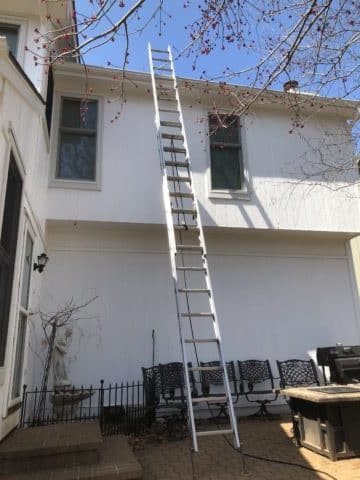
This type of work should NEVER be attempted without proper certifications, training, and safety gear.
For the average homeowner, it’s not worth the risk, and we strongly advise against attempting to clean or remove the stains yourself. (Not to mention some of the gear you’ll need will end up costing you more than the price of an inspection).
Our best advice is to get help from a local professional. If you’re outside of our Kansas City service area, you can still visit the CSIA website to find a Certified Pro near you.
Conclusion
Roofing, chimneys, fireplaces, and other masonry surfaces can suffer from different discolorations. The stain color can provide you a clue as to what caused the unusual spots, markings, or otherwise abnormal discoloration. We hope this information helps you determine your next steps to fixing and preventing stains on your chimney. If you still need help, give us a call at 913-642-6171.


